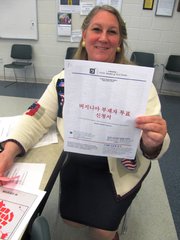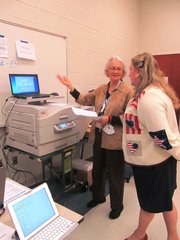Voters lined up outside Lake Anne Elementary early Tuesday morning for last year’s election. Voters reported about a 45-minute wait at Lake Anne Elementary. Photo by Amiee Freeman
“I was touched with the Korean community’s efforts to help us translate materials and provide volunteers. … And so we're trying to encourage other pockets. My next target is Vietnamese. We’ve also printed recruitment brochures in Farsi, Arabic, Chinese Korean, French, and Spanish.”
— Cameron Quinn, Fairfax County’s chief elections officer
An App for Election Day Information
Voting information for the Nov. 5 election is easily accessible on a smartphone. After downloading the county’s app for Android or iPhone, residents can:
Verify your voter registration and your registration address.
Review a sample ballot and determine your choices before driving to the poll.
Find poll location and driving directions to get there.
Link to the Office of Elections' web page for easy access to other vital information.
Download the free Fairfax County app at http://www.fairfaxc…">www.fairfaxcounty.g…, or search Fairfax County Government on Google Play or the Apple App Store. Once you download and launch the Fairfax County app, look for the “Vote” icon.
“All Fairfax County voters with smartphones can take advantage of this opportunity to get critical election information on the go,” said Fairfax County General Registrar Cameron Quinn. “The app will be a tremendous help on Election Day, Nov. 5, particularly for those coming from someplace other than home who may want driving directions.”
It’s been nearly a year since more than 450,000 Fairfax County voters cast their ballots at 237 precincts in the 2012 presidential election, and for most voters, the process was quick and painless.
But long lines and even longer wait times at some polls frustrated voters and prompted Fairfax County to investigate what went wrong.
Making sure that history does not repeat itself, Board of Supervisors Chairman Sharon Bulova set up a special bipartisan Election Commission less than two weeks after the 2012 election to look into what caused the long lines, whether poll workers were trained properly and why some voters just gave up and went home.
Last fall, the Board of Supervisors appointed a 26-member Bipartisan Election Process Improvement Commission to look into some of the problems encountered by voters and election officers during the 2012 general election, including long lines. In March this year the commission released its report, offering over 50 recommendations, including:
- Use electronic poll books at all precincts
- Avoid parent-teacher conferences on Election Day
- Encourage voters to use optically scanned ballots, reserving touch-screen machines for voters with disabilities
- Enable dedicated phone lines for the chiefs to use to reach the registrar and elections offices
- Purchase new voting equipment to modernize and improve the voting process
- Consider raising election officers’ pay and increasing the number of rovers
The Office of Elections is considering the following recommendations to determine which may be implemented.
- Refer to "electronically scanned" ballots, not “paper”
- Configure lines and precinct room layout for maximum efficiency
- Meet with EO teams the night before election to set up and for a quick review of duties
- Post maps outside rooms of co-located precincts
- Be sensitive to and assist voters with disabilities and those with limited English skills
(Read the full report at http://www.fairfaxc…">www.fairfaxcounty.g….)
Appointed by the Board of Supervisors, the 2013 Bipartisan Election Process Improvement Commission consists of county residents who represent the county's supervisory districts, communities within the county and organizations. Katherine Hanley, former chair of the the Board of Supervisors, and Stuart Mendelsohn, former Dranesville supervisor, co-chaired the commission.
One of the key reasons for the problems, election officials said, was a shortage of poll volunteers.
This year, Cameron Quinn, the county’s chief election official, and the county’s Electoral Board have been working together to implement some of the 50 recommendations made by the bipartisan committee in May.
“We’ve been doing a number of things since January to improve outreach and make things go smoothly for every voter this year,” Quinn said last week. “We've done a lot more targeting of messages to people who need it, senior and disabled population, and we’ve been able to provide more bi-lingual volunteers at precincts that need language assistance.”
In addition to printing all voting materials in English and Spanish, a federal requirement, Quinn said the county will have English/Spanish bi-lingual volunteers at every precinct, as well as Korean-speaking volunteers at some polling precincts with large Korean populations.
“I was touched with Korean community’s efforts to help us translate materials and provide volunteers,” Quinn said. “And so we're trying to encourage other pockets. My next target is Vietnamese. We’ve also printed recruitment brochures in Farsi, Arabic, Chinese Korean, French, and Spanish.”
Another key improvement was raising the pay of election volunteers, from $100 to $175 per day, which Quinn said has helped in the effort to recruit more volunteers.
The county also encouraged absentee voting, starting the process three weeks earlier at satellite sites. As of Oct. 23, Quinn said there have been more than 17,248 absentee applications, a 50 percent increase from 2012.
“The Electoral Board agreed with the vast majority of the recommendations the commission made and most of those recommendations are being implemented right now or will implemented in the future,” said Brian Schoeneman, a Fairfax County attorney and secretary of the Electoral Board.
“One thing we knew even before November was that we needed to begin thinking of replacing our aging voting equipment,” Schoeneman said. “We have made significant progress in that area and are evaluating a variety of systems with a goal of implementing a new, fully integrated system by November 2014.”
The Board of Supervisors allotted $6 million for new equipment this year, which Quinn said gives the election office “more breathing room” to implement some improvements.
Last week, the Sully District precinct, received its first Ballot on Demand machine. Adrienne Free of Fairfax, an election official stationed at the precinct, said the new technology would make it easier for both voters and volunteers.
“We have literally dozens of different ballot combinations of offices,” Free said. “With the new equipment, we won’t have to print as many ballots.”
In some election years, like the upcoming 2015 elections, election officials will juggle more than 80 different ballots to accommodate the various jurisdictional boundaries across Fairfax County.
The multiple ballots are especially difficult to handle with absentee ballots and absentee in-person voting at the satellite locations and the Government Center, where officials have to have every single ballot combination available to allow every voter in Fairfax to vote.
“Ballot on demand technology lets us get around the need to print thousands of copies of each ballot and have them available, especially in the satellites and Government Center,” Schoeneman said.
Instead, election officers can print the ballot for voters at the time they check-in, saving the time of finding the correct ballot, saving the money of printing thousands of ballots no one will ever use, and reducing errors caused by handing out incorrect ballots to voters.
“Many jurisdictions around the country are moving to this model and we hope Fairfax — if the tests are successful — will help lead the way here in Virginia,” Schoeneman said.




